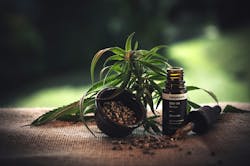Although the horticultural lighting business that Signify is acquiring from ams Osram is operating at a profit level below normal Signify levels, CEO Eric Rondolat is confident that margins will improve, and that a strong cannabis market will make it a significant contributor at Signify.
In assuring analysts during last week’s fourth-quarter results call that Fluence by Osram will turn Signify’s lively horticultural business even livelier, Rondolat also rolled out a new euphemism for cannabis, referring to it as a “bio-based crop.”
The “bio” phrase notes the medical use of cannabis that has driven the growth of the cannabis market in recent years, and that has buoyed Fluence’s top line. While Austin, TX-based Fluence also serves other horticultural sectors, the legalization of cannabis for medical and recreational purposes in many US states and in Canada helped it reach revenues of $141 million in 2021, 8 years after its founding.
Once it joins the Signify orbit, both Fluence's and Signify's Eindhoven-based Horticulture LED Solutions will continue to sell globally, with Fluence having more of a North American focus and Eindhoven a more European one. While their strengths are cannabis and noncannabis, respectively, they will each serve both product segments.*
Signify agreed in December to acquire Fluence for $272M in cash on a debt-free basis. Rondolat said last week that the deal is still expected to close in the first half of this year, pending regulatory approval and what he termed “other conditions.”
“This will strengthen our agriculture growth platform in North America and will enable us to capture the full potential of the US market for bio-based crops to which cannabis belongs, and also non-bio-based crops, building on our strong existing European footprint,” he said.
Morgan Stanley analyst Lucy Carrier quizzed Rondolat on Fluence profit levels, which she said appear to be lower than Signify’s norm. In the fourth quarter ended Dec. 31, Signify reported company-wide adjusted EBITDA margin of 13.2%.
“At this point in time, yes, Fluence is slightly below in terms of profitability,” Rondolat said. “But we think that looking at the back office costs, the SG&A [selling, general and administrative expenses], and also the optimization of purchasing and procurement, that we can bring them very quickly to the right levels.”
Rondolat described horticulture as having the highest growth rate of the businesses that Signify labels as its “growth platforms.” In addition to horticulture, those are solar lighting, 3-D printing of luminaires, and ultraviolet C-band (UV-C) disinfection products.
The Signify boss did not provide a Signify-specific growth forecast for horticulture. But he identified a global growth rate for horticultural lighting products of “more than 20% per year to $1.6 billion in 2024” and noted that “in general we see the horticultural market growing and growing nearly everywhere, and that’s the case for non-bio-based and for bio-based.
“We have already stated that our growth platforms at the end of 2021 were around €326M,” Rondolat said. “So if we add roughly €130M from Fluence, we are now into the €450M range. And of course horticulture is the biggest part of that number and will continue to impact very positively on the growth of our growth platforms.”
MARK HALPER is a contributing editor for LEDs Magazine, and an energy, technology, and business journalist ([email protected]).
*Updated Feb. 17, 2022 for Fluence and Signify global distribution plans as clarified by Signify.
For up-to-the-minute LED and SSL updates, why not follow us on Twitter? You’ll find curated content and commentary, as well as information on industry events, webcasts, and surveys on our LinkedIn Company Page and our Facebook page.






